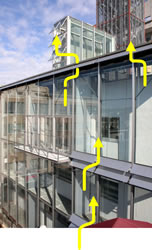Last Uploaded: August, 2010
The Frontier Center for Environmental Symbiosis Technology, Kanto-Gakuin University
 |
| Flow of air due to combined effect of double skin and solar chimney |
 |
 |
 |
 |
 |
 |
 |
 |
 |
Special Features
| Q-1 Indoor Environment |
- By making the double skin and solar chimney operable independently or in conjunction, thermal load is reduced and the indoor heat environment improved.
- Natural light intake using a solar chimney.
- Assured safety of gray water used in WC flushing, etc.
|
| Q-2 Quality of Service |
- Existing small rooms combined into a large flexible space.
- Increased floor area for research, experiment space and machinery installation, and secure research exchange space.
- Building made barrier free.
- External pipe shaft installed, improved convenience of maintenance and renewal.
- Improved earthquake resistance thanks to increased girth of surrounding walls and use of Vierendeel truss girders.
- Renewal of sashes, equipment piping and wiring, water resistance and exterior paint.
|
| Q-3 Outdoor Environment on Site |
- Addition of balconies and glass surfaces enable the activities of building users to be seen.
- Wall surface made green with fragrant rose plants, the small plaza facing it is revitalized as a place of energy and positive interaction.
- Sense of coolness brought to the surrounding area by water spray onto the double skin surface in summer.
- Building front extended towards the road, front wall surfaces aligned to create a “townscape” for the campus.
|
| LR-1 Energy |
- Use of an air-conditioning system based on geothermal heat via heat exchange piles and cool tubes.
- Air-conditioning load reduced by the double skin and solar chimney.
- Energy conserved by the use of human body detection lighting.
- Energy conserved by changing equipment and machinery from conventional to high-efficiency types.
|
| LR-2 Resources and Materials |
- Construction waste reduced by using the existing substructure in renewal.
- Water usage reduced and steps taken to protect water resources by using a rainwater utilization system and water-saving sanitary appliances.
|
| LR-3 Off-site Environment |
- Steps taken to mitigate the heat island effect by installing a rooftop biotope and green roof.
- Measures for purification of domestic waste treatment effluent, etc by adopting a wastewater treatment system.
- Measures to prevent odors of exhaust fumes from wastewater treatment tanks.
|
Other Features
- We proposed and practiced a method of "sustainable renewal" that integratedly applies various environmental symbiosis technologies to decrepit existing research and experimental facilities, thereby revitalizing them.
- We have measured and verified the effectiveness of the methods and technologies over the passage of time from both environmental and equipment aspects. At the same time, we have studied the environmental load reduction effects through all phases from construction to operation.
- We retained the characteristic shape of the existing building as an "architectural memory", aiming for temporal continuity of the image of the campus space. We also took scenic "eye stoppers" into account.
- The double skin was made as a hanging structure, thus avoiding disturbance to the underground piping within the premises.
|
These cases are described based on assessment results obtained using
CASBEE.
CASBEE is a method for rating the environmental performance of buildings using
Building Environmental Efficiency (BEE) as an indicator, which is based on the results of
separate scores obtained for Q-1~Q-3 (Quality) and LR-1~LR-3 (Load Reduction).















 Next Building
Next Building















 | Copyright © 2008 Institute for Building Environment and Energy Conservation, All Rights Reserved.
| Copyright © 2008 Institute for Building Environment and Energy Conservation, All Rights Reserved.